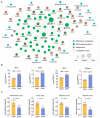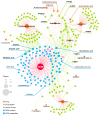Multi-Omics and Network-Based Drug Repurposing for Septic Cardiomyopathy
- PMID: 39861106
- PMCID: PMC11768530
- DOI: 10.3390/ph18010043
Multi-Omics and Network-Based Drug Repurposing for Septic Cardiomyopathy
Erratum in
-
Correction: Liu et al. Multi-Omics and Network-Based Drug Repurposing for Septic Cardiomyopathy. Pharmaceuticals 2025, 18, 43.Pharmaceuticals (Basel). 2025 Jul 14;18(7):1040. doi: 10.3390/ph18071040. Pharmaceuticals (Basel). 2025. PMID: 40732369 Free PMC article.
Abstract
Background/objectives: Septic cardiomyopathy (SCM) is a severe cardiac complication of sepsis, characterized by cardiac dysfunction with limited effective treatments. This study aimed to identify repurposable drugs for SCM by integrated multi-omics and network analyses.
Methods: We generated a mouse model of SCM induced by lipopolysaccharide (LPS) and then obtained comprehensive metabolic and genetic data from SCM mouse hearts using ultra-performance liquid chromatography-tandem mass spectrometry (UPLC-MS/MS) and RNA sequencing (RNA-seq). Using network proximity analysis, we screened for FDA-approved drugs that interact with SCM-associated pathways. Additionally, we tested the cardioprotective effects of two drug candidates in the SCM mouse model and explored their mechanism-of-action in H9c2 cells.
Results: Network analysis identified 129 drugs associated with SCM, which were refined to 14 drug candidates based on strong network predictions, proven anti-infective effects, suitability for ICU use, and minimal side effects. Among them, acetaminophen and pyridoxal phosphate significantly improved cardiac function in SCM moues, as demonstrated by the increased ejection fraction (EF) and fractional shortening (FS), and the reduced levels of cardiac injury biomarkers: B-type natriuretic peptide (BNP) and cardiac troponin I (cTn-I). In vitro assays revealed that acetaminophen inhibited prostaglandin synthesis, reducing inflammation, while pyridoxal phosphate restored amino acid balance, supporting cellular function. These findings suggest that both drugs possess protective effects against SCM.
Conclusions: This study provides a robust platform for drug repurposing in SCM, identifying acetaminophen and pyridoxal phosphate as promising candidates for clinical translation, with the potential to improve treatment outcomes in septic patients with cardiac complications.
Keywords: LC-MS; acetaminophen; metabolomics; network medicine; transcriptomics.
Conflict of interest statement
The authors declare no conflicts of interest.
Figures








Similar articles
-
Systemic pharmacological treatments for chronic plaque psoriasis: a network meta-analysis.Cochrane Database Syst Rev. 2021 Apr 19;4(4):CD011535. doi: 10.1002/14651858.CD011535.pub4. Cochrane Database Syst Rev. 2021. Update in: Cochrane Database Syst Rev. 2022 May 23;5:CD011535. doi: 10.1002/14651858.CD011535.pub5. PMID: 33871055 Free PMC article. Updated.
-
Systemic Inflammatory Response Syndrome.2025 Jun 20. In: StatPearls [Internet]. Treasure Island (FL): StatPearls Publishing; 2025 Jan–. 2025 Jun 20. In: StatPearls [Internet]. Treasure Island (FL): StatPearls Publishing; 2025 Jan–. PMID: 31613449 Free Books & Documents.
-
Systemic pharmacological treatments for chronic plaque psoriasis: a network meta-analysis.Cochrane Database Syst Rev. 2020 Jan 9;1(1):CD011535. doi: 10.1002/14651858.CD011535.pub3. Cochrane Database Syst Rev. 2020. Update in: Cochrane Database Syst Rev. 2021 Apr 19;4:CD011535. doi: 10.1002/14651858.CD011535.pub4. PMID: 31917873 Free PMC article. Updated.
-
Systemic treatments for metastatic cutaneous melanoma.Cochrane Database Syst Rev. 2018 Feb 6;2(2):CD011123. doi: 10.1002/14651858.CD011123.pub2. Cochrane Database Syst Rev. 2018. PMID: 29405038 Free PMC article.
-
Systemic pharmacological treatments for chronic plaque psoriasis: a network meta-analysis.Cochrane Database Syst Rev. 2017 Dec 22;12(12):CD011535. doi: 10.1002/14651858.CD011535.pub2. Cochrane Database Syst Rev. 2017. Update in: Cochrane Database Syst Rev. 2020 Jan 9;1:CD011535. doi: 10.1002/14651858.CD011535.pub3. PMID: 29271481 Free PMC article. Updated.
Cited by
-
Correction: Liu et al. Multi-Omics and Network-Based Drug Repurposing for Septic Cardiomyopathy. Pharmaceuticals 2025, 18, 43.Pharmaceuticals (Basel). 2025 Jul 14;18(7):1040. doi: 10.3390/ph18071040. Pharmaceuticals (Basel). 2025. PMID: 40732369 Free PMC article.
-
Research Progress of Biomarkers for Sepsis and Precision Medicine.Emerg Med Int. 2025 Jul 7;2025:4585495. doi: 10.1155/emmi/4585495. eCollection 2025. Emerg Med Int. 2025. PMID: 40661134 Free PMC article. Review.
-
Amide Proton Transfer-Weighted MR Imaging and Signal Variations in a Rat Model of Lipopolysaccharide-Induced Sepsis-Associated Encephalopathy.Metabolites. 2025 Jul 9;15(7):465. doi: 10.3390/metabo15070465. Metabolites. 2025. PMID: 40710565 Free PMC article.
-
From cardiac injury to omics signatures: a narrative review on biomarkers in septic cardiomyopathy.Clin Exp Med. 2025 Aug 21;25(1):298. doi: 10.1007/s10238-025-01842-5. Clin Exp Med. 2025. PMID: 40839200 Review.
References
-
- Rudd K.E., Johnson S.C., Agesa K.M., Shackelford K.A., Tsoi D., Kievlan D.R., Colombara D.V., Ikuta K.S., Kissoon N., Finfer S., et al. Global, Regional, and National Sepsis Incidence and Mortality, 1990–2017: Analysis for the Global Burden of Disease Study. Lancet. 2020;395:200–211. doi: 10.1016/S0140-6736(19)32989-7. - DOI - PMC - PubMed
Grants and funding
LinkOut - more resources
Full Text Sources
Research Materials

